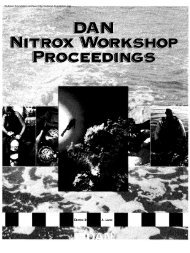Management of Mild or Marginal Decompression Illness in Remote ...
Management of Mild or Marginal Decompression Illness in Remote ...
Management of Mild or Marginal Decompression Illness in Remote ...
You also want an ePaper? Increase the reach of your titles
YUMPU automatically turns print PDFs into web optimized ePapers that Google loves.
Data Clean<strong>in</strong>g <strong>in</strong> DIRF 2001 "Doubt, No Doubt" and DIRF 1998-2002<br />
The problems outl<strong>in</strong>ed above are familiar to any analyst <strong>of</strong> retrospective data, and the<br />
best solution is to study the issue prospectively with a predeterm<strong>in</strong>ed series <strong>of</strong> questions<br />
us<strong>in</strong>g a well thought out experimental design. Even when the questions were not<br />
thought out <strong>in</strong> advance, contact<strong>in</strong>g the subject and <strong>in</strong>terview<strong>in</strong>g him a second time can<br />
<strong>of</strong>ten obta<strong>in</strong> critical data. This technique was used to <strong>in</strong> two <strong>in</strong>stances described previously<br />
to re-study latency <strong>in</strong> cases <strong>of</strong> paralysis (DARF 1990-1997) and mot<strong>or</strong> weakness<br />
(DIRF 1998-2002). The DIRF 1998-2002 was also exam<strong>in</strong>ed f<strong>or</strong> the effect <strong>of</strong> treatment<br />
delay on mild cases.<br />
When repeat<strong>in</strong>g an <strong>in</strong>terview is not possible, analytical problems can be confronted retrospectively<br />
by apply<strong>in</strong>g filters to the dataset that categ<strong>or</strong>ize the cases by severity and<br />
earmark the diagnostically ambiguous ones. This technique was used <strong>in</strong> the DIRF 2001<br />
"Doubt, no doubt" dataset. Although this process can <strong>in</strong>troduce bias through the filter<br />
design, if the criteria are clearly def<strong>in</strong>ed, consistently adhered to and appropriately<br />
applied, then the analysis will be mean<strong>in</strong>gful. A m<strong>or</strong>e detailed discussion <strong>of</strong> the analysis<br />
<strong>of</strong> effect <strong>of</strong> delay to treatment <strong>in</strong> mild cases <strong>in</strong> these data sets follows.<br />
Effect <strong>of</strong> Delay to Recompression Treatment on the DIRF 2001 "Doubt, No Doubt" Data<br />
The "Doubt, no doubt" data set was an attempt to retrospectively deal with the question<br />
<strong>of</strong> diagnostic ambiguity. F<strong>or</strong> the DCI diagnosis symposium held at Duke<br />
University <strong>in</strong> April 2003, DAN developed a series <strong>of</strong> criteria to s<strong>or</strong>t DCI cases <strong>in</strong> the<br />
<strong>in</strong>jury databases by severity and diagnostic confidence.<br />
The best data available were the 522 cases collected us<strong>in</strong>g the DIRF dur<strong>in</strong>g the calendar<br />
year 2001 (20). All cases had received recompression; theref<strong>or</strong>e, the response to treatment<br />
was known. Because the DIRF has a field that allows the rep<strong>or</strong>t<strong>in</strong>g physician to<br />
list his f<strong>in</strong>al diagnosis, the op<strong>in</strong>ion <strong>of</strong> the rep<strong>or</strong>t<strong>in</strong>g physician was used as the primary<br />
screen f<strong>or</strong> diagnostic confidence. All cases still listed as DCS, AGE <strong>or</strong> DCI by the<br />
rep<strong>or</strong>t<strong>in</strong>g physician were classified as no doubt. Cases listed as "ambiguous," "lung<br />
barotrauma without AGE," "other," <strong>or</strong> "unrelated to pressure" were classified as doubtful<br />
(doubt).<br />
Dr. Petar Denoble <strong>of</strong> DAN Research applied additional filter<strong>in</strong>g to the dataset. He<br />
reclassified the rema<strong>in</strong><strong>in</strong>g no doubt cases dur<strong>in</strong>g a detailed chart review by reclassify<strong>in</strong>g<br />
as doubtful cases that did not have the follow<strong>in</strong>g criteria:<br />
• F<strong>or</strong> AGE, symptom onset greater than 15 m<strong>in</strong>utes post dive, cases without at least<br />
one cerebral symptom, and cases with symptom duration <strong>of</strong> less than 15 m<strong>in</strong>utes.<br />
• F<strong>or</strong> DCS, s<strong>in</strong>gle dives to less than 30 fsw, symptom onset m<strong>or</strong>e than 48 hours after the<br />
dive unless there was an <strong>in</strong>terven<strong>in</strong>g altitude exposure, and symptoms that persisted<br />
less than 20 m<strong>in</strong>utes with O2 <strong>or</strong> less than 60 m<strong>in</strong>utes without O2.<br />
To better understand severity at the time <strong>of</strong> presentation, the cases were hierarchically<br />
categ<strong>or</strong>ized <strong>in</strong>to the follow<strong>in</strong>g b<strong>in</strong>s acc<strong>or</strong>d<strong>in</strong>g to the most severe symptoms: (1) mot<strong>or</strong><br />
weakness <strong>or</strong> paralysis; (2) mental status changes <strong>or</strong> <strong>in</strong>volvement <strong>of</strong> co<strong>or</strong>d<strong>in</strong>ation <strong>or</strong> the<br />
<strong>Management</strong> <strong>of</strong> <strong>Mild</strong> <strong>or</strong> <strong>Marg<strong>in</strong>al</strong> <strong>Decompression</strong> <strong>Illness</strong> <strong>in</strong> <strong>Remote</strong> Locations W<strong>or</strong>kshop Proceed<strong>in</strong>gs<br />
81
















